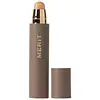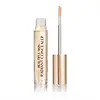Merit Beauty The Minimalist Perfecting Complexion Foundation and Concealer Stick Versus Charlotte Tilbury Beautiful Skin Radiant Concealer
What's inside
What's inside
 Key Ingredients
Key Ingredients

 Benefits
Benefits

 Concerns
Concerns

 Ingredients Side-by-side
Ingredients Side-by-side

Hydrogenated Polydecene
EmollientCaprylic/Capric Triglyceride
MaskingOctyldodecanol
EmollientSilica
AbrasivePolyethylene
AbrasiveDipentaerythrityl Hexahydroxystearate/Hexastearate/Hexarosinate
Skin ConditioningHydrogenated Polyisobutene
EmollientCopernicia Cerifera Wax
Synthetic Wax
AbrasiveTriethoxycaprylylsilane
Cera Microcristallina
Emulsion StabilisingSorbitan Isostearate
EmulsifyingPancratium Maritimum Extract
BleachingTocopheryl Acetate
AntioxidantDimethicone
EmollientCaprylyl Glycol
EmollientPropylene Carbonate
SolventEthylhexylglycerin
Skin Conditioning1,2-Hexanediol
Skin ConditioningStearalkonium Hectorite
Gel FormingGlycerin
HumectantWater
Skin ConditioningMica
Cosmetic ColorantBHT
AntioxidantCI 77491
Cosmetic ColorantCI 77891
Cosmetic ColorantHydrogenated Polydecene, Caprylic/Capric Triglyceride, Octyldodecanol, Silica, Polyethylene, Dipentaerythrityl Hexahydroxystearate/Hexastearate/Hexarosinate, Hydrogenated Polyisobutene, Copernicia Cerifera Wax, Synthetic Wax, Triethoxycaprylylsilane, Cera Microcristallina, Sorbitan Isostearate, Pancratium Maritimum Extract, Tocopheryl Acetate, Dimethicone, Caprylyl Glycol, Propylene Carbonate, Ethylhexylglycerin, 1,2-Hexanediol, Stearalkonium Hectorite, Glycerin, Water, Mica, BHT, CI 77491, CI 77891
Water
Skin ConditioningDicaprylyl Ether
EmollientPolyglyceryl-3 Polyricinoleate
EmulsifyingGlycerin
HumectantCoco-Caprylate/Caprate
EmollientPolyglyceryl-3 Diisostearate
EmulsifyingNiacinamide
SmoothingMica
Cosmetic ColorantHydrogenated Castor Oil
EmollientAcacia Decurrens/Jojoba/Sunflower Seed Wax Polyglyceryl-3 Esters
EmollientCollagen
MoisturisingMagnesium Sulfate
Silica
AbrasiveLauroyl Lysine
Skin ConditioningAluminum Hydroxide
EmollientSqualane
EmollientLevulinic Acid
PerfumingSodium Dehydroacetate
PreservativeSodium Levulinate
Skin ConditioningTocopherol
AntioxidantSodium Lauroyl Glutamate
Camellia Japonica Seed Oil
EmollientHydrolyzed Sodium Hyaluronate
Skin ConditioningHelianthus Annuus Seed Oil
EmollientLysine
Skin ConditioningParfum
MaskingMagnesium Chloride
Sorbitol
HumectantPropanediol
SolventCaprylic/Capric Triglyceride
MaskingCetyl Palmitate
Emollient1,2-Hexanediol
Skin ConditioningCaprylyl Glycol
EmollientPolysorbate 80
EmulsifyingSorbitan Stearate
EmulsifyingXanthan Gum
EmulsifyingSodium Benzoate
MaskingCitric Acid
BufferingHydrogenated Lecithin
EmulsifyingAscorbic Acid
AntioxidantColloidal Gold
AntimicrobialGlutathione
Palmitoyl Tetrapeptide-10
Skin ConditioningCI 77891
Cosmetic ColorantIron Oxides
Water, Dicaprylyl Ether, Polyglyceryl-3 Polyricinoleate, Glycerin, Coco-Caprylate/Caprate, Polyglyceryl-3 Diisostearate, Niacinamide, Mica, Hydrogenated Castor Oil, Acacia Decurrens/Jojoba/Sunflower Seed Wax Polyglyceryl-3 Esters, Collagen, Magnesium Sulfate, Silica, Lauroyl Lysine, Aluminum Hydroxide, Squalane, Levulinic Acid, Sodium Dehydroacetate, Sodium Levulinate, Tocopherol, Sodium Lauroyl Glutamate, Camellia Japonica Seed Oil, Hydrolyzed Sodium Hyaluronate, Helianthus Annuus Seed Oil, Lysine, Parfum, Magnesium Chloride, Sorbitol, Propanediol, Caprylic/Capric Triglyceride, Cetyl Palmitate, 1,2-Hexanediol, Caprylyl Glycol, Polysorbate 80, Sorbitan Stearate, Xanthan Gum, Sodium Benzoate, Citric Acid, Hydrogenated Lecithin, Ascorbic Acid, Colloidal Gold, Glutathione, Palmitoyl Tetrapeptide-10, CI 77891, Iron Oxides
 Reviews
Reviews

Ingredients Explained
These ingredients are found in both products.
Ingredients higher up in an ingredient list are typically present in a larger amount.
1,2-Hexanediol is a synthetic liquid and another multi-functional powerhouse.
It is a:
- Humectant, drawing moisture into the skin
- Emollient, helping to soften skin
- Solvent, dispersing and stabilizing formulas
- Preservative booster, enhancing the antimicrobial activity of other preservatives
This ingredient is an emollient, solvent, and texture enhancer. It is considered a skin-softener by helping the skin prevent moisture loss.
It helps thicken a product's formula and makes it easier to spread by dissolving clumping compounds.
Caprylic Triglyceride is made by combining glycerin with coconut oil, forming a clear liquid.
While there is an assumption Caprylic Triglyceride can clog pores due to it being derived from coconut oil, there is no research supporting this.
Learn more about Caprylic/Capric TriglycerideCaprylyl Glycol is a humectant and emollient, meaning it attracts and preserves moisture.
It is a common ingredient in many products, especially those designed to hydrate skin. The primary benefits are retaining moisture, skin softening, and promoting a healthy skin barrier.
Though Caprylyl Glycol is an alcohol derived from fatty acids, it is not the kind that can dry out skin.
This ingredient is also used as a preservative to extend the life of products. It has slight antimicrobial properties.
Learn more about Caprylyl GlycolCi 77891 is a white pigment from Titanium dioxide. It is naturally found in minerals such as rutile and ilmenite.
It's main function is to add a white color to cosmetics. It can also be mixed with other colors to create different shades.
Ci 77891 is commonly found in sunscreens due to its ability to block UV rays.
Learn more about CI 77891Glycerin is already naturally found in your skin. It helps moisturize and protect your skin.
A study from 2016 found glycerin to be more effective as a humectant than AHAs and hyaluronic acid.
As a humectant, it helps the skin stay hydrated by pulling moisture to your skin. The low molecular weight of glycerin allows it to pull moisture into the deeper layers of your skin.
Hydrated skin improves your skin barrier; Your skin barrier helps protect against irritants and bacteria.
Glycerin has also been found to have antimicrobial and antiviral properties. Due to these properties, glycerin is often used in wound and burn treatments.
In cosmetics, glycerin is usually derived from plants such as soybean or palm. However, it can also be sourced from animals, such as tallow or animal fat.
This ingredient is organic, colorless, odorless, and non-toxic.
Glycerin is the name for this ingredient in American English. British English uses Glycerol/Glycerine.
Learn more about GlycerinMica is a naturally occurring mineral used to add shimmer and color in cosmetics. It can also help improve the texture of a product or give it an opaque, white/silver color.
Serecite is the name for very fine but ragged grains of mica.
This ingredient is often coated with metal oxides like titanium dioxide. Trace amounts of heavy metals may be found in mica, but these metals are not harmful in our personal products.
Mica has been used since prehistoric times throughout the world. Ancient Egyptian, Indian, Greek, Roman, Aztec, and Chinese civilizations have used mica.
Learn more about MicaSilica, also known as silicon dioxide, is a naturally occurring mineral. It is used as a fine, spherical, and porous powder in cosmetics.
Though it has exfoliant properties, the function of silica varies depending on the product.
The unique structure of silica enhances the spreadability and adds smoothness, making it a great texture enhancer.
It is also used as an active carrier, emulsifier, and mattifier due to its ability to absorb excess oil.
In some products, tiny microneedles called spicules are made from silica or hydrolyzed sponge. When you rub them in, they lightly polish away dead skin layers and enhance the penetration of active ingredients.
Learn more about SilicaWater. It's the most common cosmetic ingredient of all. You'll usually see it at the top of ingredient lists, meaning that it makes up the largest part of the product.
So why is it so popular? Water most often acts as a solvent - this means that it helps dissolve other ingredients into the formulation.
You'll also recognize water as that liquid we all need to stay alive. If you see this, drink a glass of water. Stay hydrated!
Learn more about Water